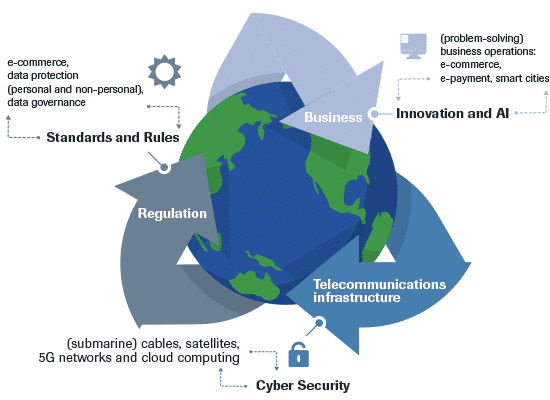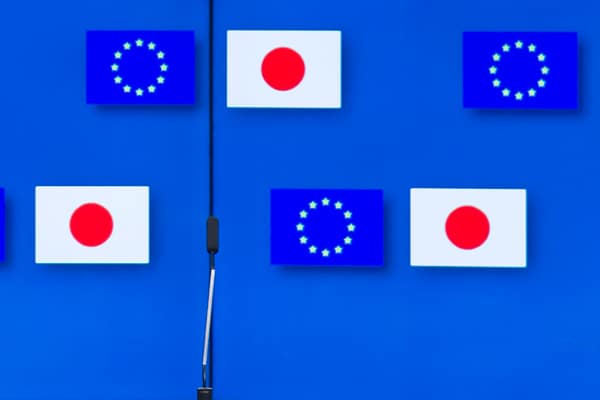Theme1
The 2019 EU-Japan Connectivity Partnership paves the way for EU-Japan cooperation on all three practical elements of digital connectivity: telecommunications infrastructure, business and regulation. Cooperation should be implemented at both the practical and strategic levels, and beyond the bilateral agenda.
Summary
In implementing the EU-Japan Partnership on Sustainable Connectivity and Quality Infrastructure, the digital field offers practical opportunities for the two partners to further shared objectives. Set against the context of a hardening US-China trade-tech conflict, the EU and Japan should focus on the promotion of data security and trust in data flows at the global level, and on nurturing competitive digital businesses with a strong global presence. In addition, cooperation on the digital development agenda is crucial to ensure that third countries also benefit from the data revolution in their development and can contribute to a convergence of norms on data governance. A broader engagement between stakeholders with each other’s strategic thought on digital connectivity’s defensive strand is required for success in these fields. Taken together, this means pushing cooperation beyond the bilateral agenda, while also creating more lines of communication to compare notes on the notion of digital strategic autonomy.
Analysis
In recent years the EU and Japan have come a long way in broadening and deepening their bilateral relationship. The free trade deal, political cooperation agreement, sustainable connectivity partnership and mutual adequacy decision on the sharing of personal data of 2019 are evidence of the political momentum. Moving from paper to practice, the vast digital agenda offers practical opportunities to further shared objectives.
Taking cooperation beyond the bilateral agenda, the focus should be on the promotion of data security and trust in data flows at the global level, and on nurturing competitive digital businesses with a strong global presence. In addition, cooperation on the digital development agenda in third countries –in particular, emerging economies in Asia and Africa– seems promising. Aiming for digital governance to proceed in an open and transparent system that continues to benefit their own peoples and citizens in third countries, the EU and Japan stand to benefit from coordinated action in multilateral settings like the G20 and World Trade Organisation (WTO), as well as in third countries, in areas such as data for development, digital capacity building and digital financial inclusion.
True engagement on each other’s strategic thought –including on digital connectivity’s defensive strand and (digital) strategic autonomy– is necessary for success in these fields. This requires that new platforms are created that facilitate discussions between stakeholders, just as the EU-China Connectivity Platform facilitates dialogue on transport connectivity with China and the Asia-Europe Foundation (ASEF) furthers human connectivity between European and Asian countries.
Society-centred policies
Set against the context of a hardening US-China trade-tech conflict, the ongoing fourth industrial revolution is fundamentally changing the way in which people live, work and interact. Following mechanisation thanks to steam and water, mass production enabled by electricity, and automation owing to digital tools including the Internet, the fourth industrial revolution is now facilitating robotisation by way of integrating information and communications technology (ICT) in all of society. The new technology revolution is connecting not just billions of people through mobile devices but also –and more profoundly– introducing autonomous systems in society (ranging from vehicles to military systems) and facilitating new businesses and business models. As the Japanese say, we are entering Society 5.0.2
As most technological development today is carried out by companies, governments need to ensure that these technologies continue to benefit the people. This means devising policies that are not technology-oriented but socially-oriented, or what the Japanese government calls a ‘human-centred digital society’. This clearly resembles the ‘human-centric’ approach put forward in the EU’s digital strategy. But while Japan’s focus seems to be on the collective, the EU’s focus is on the (European) individual, a difference that might seem insignificant but is actually a sign of divergent approaches and preferred solutions. That said, both sides stress the values of openness, sustainability and inclusiveness. And, putting citizens’ interests first clearly differentiates the EU and Japan from the US, which prioritises companies, while in China technology is to serve the state.
While for China data are something to be controlled, and for the US something to be commercialised, the EU and Japan thus share the understanding that data are to be protected. This is important, as it distinguishes the two partners from countries with restrictive data transfer regulations that associate data governance with political and social control. The growing presence of these countries’ technology champions –such as Huawei, Alibaba, ZTE and Tencent, in the case of China– supported by the state will further their vision for state-led Internet governance and may facilitate its espionage and security services and even export them to third countries. Action is thus needed to prevent the leveraging of investments in network infrastructure abroad to evangelise restricted visions for Internet governance and harmful digital protectionism.
Digital connectivity
This is getting to the heart of the question: what are the objectives –and, flowing from these, the opportunities and challenges– for EU-Japan cooperation in digital connectivity? Answers to this question should be sought in each of the three practical elements of digital connectivity –namely telecommunications infrastructure, business and regulation–. These parallel connectivity’s three strands of physical, institutional and people-to-people links. Importantly, each element has a strategic dimension that should incentivise governments to act in these fields, both individually and jointly. As shown in Figure 1, these are cyber security, standards and rules, and innovation and AI.

Regulation
The shared objectives of the EU and Japan are most obvious in the field of regulation, where cooperation is well on track. Here, key questions are how to ensure the free, open and secure flow of data in the digital domain; how to reconcile regulatory differences between countries; and how to shift to multi-layered, multi-stakeholder approaches that address the gap between incumbent regulations and rapid technological innovations.
For its part, the EU has been a leading force internationally to promote privacy regulations through the General Data Protection Regulation (GDPR). The Union leverages its regulatory power through the attraction of its single market combined with adequacy decisions. It aims to further free flows of data between Europe and countries with a comparable level of protection of personal data –its first success being the mutual adequacy decision with Japan in early 2019– and thereby to spread its norms on data privacy beyond its borders. Countries worldwide –ranging from India to Singapore and even the US– are taking the GDPR as a starting point and inspiration for regulation within their own borders.
For its part, Japan has been the staunchest promotor of the Data Free Flow with Trust (DFFT), starting with Prime Minister Shinzo Abe’s visionary speech in Davos in 2019. Since then, the Japanese government has been furthering conversations worldwide –cooperating with like-minded partners like the EU and US, but also engaging with the likes of China and Saudi Arabia in the G20 context.
Clearly, on data regulation there is a convergence of interests and approach between the EU and Japan. But, as Guntram Wolff eloquently points out, referees do not win. The EU and Japan thus need to step up their act to ensure that they remain players in the digital field also.
Problem-solving business
The big players in the digital field today are the US and China. The big tech-companies from these two countries dominate the digital platforms: Google, Apple, Facebook and Amazon (GAFA) from the US and Baidu, Alibaba and Tencent (BAT) from China. Looking towards the future, these companies benefit from their established position in terms of the (personal) data they own and allow them to continuously improve their products –a position that is increasingly difficult for any newcomer to catch up with–.
While the EU and Japan are said to have lost the battle for personal data (in the business-to-consumer field), they are preparing to do better in the battle for industrial data (or business-to-business) that is only now beginning. Acting on the awareness that AI x data equals innovation,3 both are investing in Artificial Intelligence (AI) –both as an enabler and addressing its negative aspects– and in promoting the transfer of research success to business applications. Aiming to nurture and retain (problem-solving) businesses, both are also devising policies to assist promising start-ups, also to avoid losing them to US or Chinese giants during the scale-up. After all, the EU and Japan have the talent to compete with the US and China on AI and rank high on research but lag behind in commercial AI adoption and funding.
Beyond AI and innovation, the question is how to harness the full potential of data and the digital economy, while maintaining a level playing field and avoiding inefficient protection of domestic players. This challenge is shared by policymakers across the globe. Specifically, it involves a reconsideration of competition policy (including ‘platform fairness’), privacy protection and taxation, and, ultimately, the question of (digital) strategic autonomy.
The EU and Japan stand to benefit from more engagement with each other’s strategic thought and best practices in these fields. More and regular meetings between government officials, experts and representatives of business (federations) and banks –in so-called Track 1.5 settings– combined with joint research will contribute to this purpose. Also, the two partners would do well to coordinate their action and expand their presence in third countries, where Chinese companies are increasingly present and/or investing heavily in local unicorns, thereby gaining access to (local) data and spreading their norms.
This is acting on the real need in emerging Asia –and arguably also in Africa– for the active participation of Japanese, US and European companies in these countries’ digital transformation processes. A multi-stakeholder platform including representatives from government, business (federations) and academia from the EU and Japan with local stakeholders can help identify government concerns/objectives and business opportunities. Obviously, this is not easy considering that Japanese and European companies are also competitors in third markets. Considering each other mostly as rivals in obtaining short-term gains, however, overlooks the longer-term benefits of cooperation and coordination, that is, building a free and open data distributions place that will enlarge the ‘digital economic pie’ for all companies.
Telecommunications infrastructure
Whereas telecommunications networks in the EU and Japan are primarily an internal affair, the security of these networks is a sensitive but vital topic, where both sides stand to gain from information sharing and best-practice learning. This is an argument for more engagement also in digital connectivity’s defensive strand, in recognition of the fact that governments need to act on the (security) challenges that come with connectivity, mainly due to divergences in modalities, standards and norms. After all, upholding norms and standards in a more (digitally) connected world must –in specific cases and for specific purposes– also include a willingness to put limits to certain connections.
A prime example in this regard is the debate (and policy decisions) on the security of next-generation telecommunications infrastructure, and the role of Chinese equipment provider Huawei within this. Even if the EU and Japan share the concern of Huawei as an operator that cannot be seen to be independent from the Chinese state, the process of getting to a decision on whether to allow Huawei as an operator in the 5G networks has been quite different –even if, in the long term, the endpoint may not be all that far apart–.
Subtly, the Japanese government shut out (although it did not formally ban) Huawei by allowing only ‘trusted operators’ for reasons of national security. This makes it difficult for Chinese companies to obtain licences, due to Japanese experience with Chinese espionage activities, problems with transparency, and the companies’ links to the Chinese Communist Party (CCP). At the same time, the Japanese government is seeking to produce (domestic) technology solutions –that is, nurturing Japanese providers into key players in 6G–. If Japanese operators like NEC and Fujitsu, which are already top players in Japan, can become global players in telecommunications equipment, this would help avert today’s problem of governments being forced into a choice between a limited number of operators.
For their part, EU member states –which have the competence to act in this field, not the EU– are less straightforward in their considerations and priorities. As governments attempted to avoid a hard decision, this contributed to a very public and politicised debate on the matter. Only in October 2019 did the EU publish a coordinated risk assessment for the cyber security of 5G networks, followed in January 2020 by an EU toolbox for risk mitigation recommendations. This has not prevented EU member states from acting in different ways, however.
European capitals have different starting points –that is, 4G operators– and their capabilities and approaches (to national and economic security) also vary. For example, while France considers telecommunication operators critical actors, other member states have treated telecoms as a commercial issue. Separately, the capacity to ensure network security differs between member states, which has led to calls for intra-European assistance. Several governments in Western Europe have now opted to keep Huawei out of the ‘core network’ while allowing it on the periphery. Even if this seems a more Huawei-friendly approach, some telecommunications experts consider it a ‘kiss of death’, arguing that it essentially degrades the company to a third-tier supplier that will play an increasingly small role, as further development grows from the core.
What this also shows is that the challenge of balancing costs and risks in digital infrastructure will not go away. In considering their future paths, relevant actors in the EU and its member states stand to benefit from information and best-practice exchange with their Japanese counterparts, who face similar challenges and know China better than most Europeans.
Digital ODA
Last but not least, the EU and Japan would do well to consider all three dimensions of digital connectivity not just in a bilateral context. After all, shared objectives in the digital field extend beyond the EU and Japanese borders, and also include third countries –in particular, emerging economies in Asia and Africa–. The Connectivity Partnership specifically mentions the Western Balkans, Eastern Europe, Central Asia, the Indo-Pacific and Africa. So, in implementing the connectivity partnership, why not aim for a shared agenda on digital development assistance that focuses on an Open and Connected Ring around Europe (OCRE)? This may be promoted as the other side of the coin of the Free and Open Indo-Pacific championed by Japan and the US and provides clear guidance on the type of projects to be pursued.
In essence, digital Official Development Assistance (ODA) entails technical assistance to developing countries, helping them to address the digital challenge that also faces developed countries. There are essentially two reasons to do so: (1) to ensure that these countries also benefit from the data revolution in their development; and (2) to further cooperation that also contributes to a convergence on norms.
The idea for this is not new: in fact, Japan’s digital agenda dates back to 2000, while the EU developed a Digital4Development agenda in recent years, as have individual member states like the Netherlands. That said, these digital ODA programmes need to be properly budgeted and staffed (which is not the case today at the EU-level) in order to be successful. In addition, both European and Japanese actors should update their policies in this area and stand to benefit from better the coordination of their efforts. The Memorandum of Understanding signed between the Japanese development organisation JICA and the European Investment Bank (EIB) –which aims for cooperation on microfinance and technical cooperation– can be instrumental towards this end. In addition, coordination is needed at the policy level between the European Commission’s development and telecommunications directorates-general (DG DEVCO and DG CONNECT) and Japan’s Ministry of Foreign Affairs, as well as between their (policy-oriented) research divisions.
In the regulatory field, the digital ODA-agenda should focus primarily on digital capacity building –that is, assisting third countries on how to establish data protection structures–. Adding to this a business dimension could help to ensure that these countries also benefit from data for their own development, rather than allowing foreign companies to gather local data and take it back to their own countries for their own benefit. Separately, digital financial inclusion is a promising agenda, where trilateral cooperation with Indian companies with a proved track record could facilitate improved access to countries with large Indian diasporas and/or Muslim populations. Finally, on the telecommunications infrastructure side, digital ODA can play a role in helping to design 5G infrastructure.
Conclusions
As the fourth industrial revolution unfolds and strategic rivalry intensifies, EU-Japan cooperation on digital connectivity is needed to further the two like-minded partners’ shared objectives. In implementing the 2019 Connectivity Partnership, cooperation should be taken beyond the bilateral level, towards multilateral settings and in third countries. Multilaterally, a joint push for human-centred, ethical AI can help promote data security and in data flows with trust –that is, the regulatory agenda, and with that, norms and standards that fend off digital protectionism. In third countries, multi-stakeholder coordination can further the presence of European and Japanese digital companies, while ODA in each of digital connectivity’s three strands could offer a promising way to further values-based cooperation. More engagement between European and Japanese stakeholders’ strategic thought on digital connectivity’s defensive strand is required for success in these fields. Taken together, this means pushing cooperation beyond the bilateral agenda, while also creating more lines of communication to compare notes, including ideas on the notion of digital strategic autonomy.
Maaike Okano-Heijmans
Senior Research Fellow at the Netherlands Institute for International Relations Clingendael at The Hague and Visiting Lecturer at the University of Leiden | @MaaikeOh
1 This Analysis of the Elcano Royal Institute is an adapted version of the author’s presentation at the conference ‘Innovation and Connectivity: Key Drivers in EU-Japan Cooperation’ hosted by the Elcano Royal Institute in Madrid on 20 February 2020. An event recap is available online. The author wishes to acknowledge the valuable feedback and discussions at that conference.
2 As put forward by the Japanese government, the road to the super-smart Society 5.0 has led from the hunter-gatherer society (1.0), to the agrarian (2.0), the industrial (3.0) and the information society (4.0) to one where the various social challenges can be resolved by incorporating the innovations of the fourth industrial revolution –eg, the Internet of Things, big data, artificial intelligence (AI), robotics and the sharing economy– into every industry and social life.
3 G20 Osaka and beyond: addressing opportunities and challenges in the digital age, unpublished presentation by Tetsuro Fukunaga, Director-General at the Japanese Ministry of Economy, Trade and Industry.
Eu-Japan Summit 2017 (cropped image). Photo: European Council President (CC BY-NC-ND 2.0)



